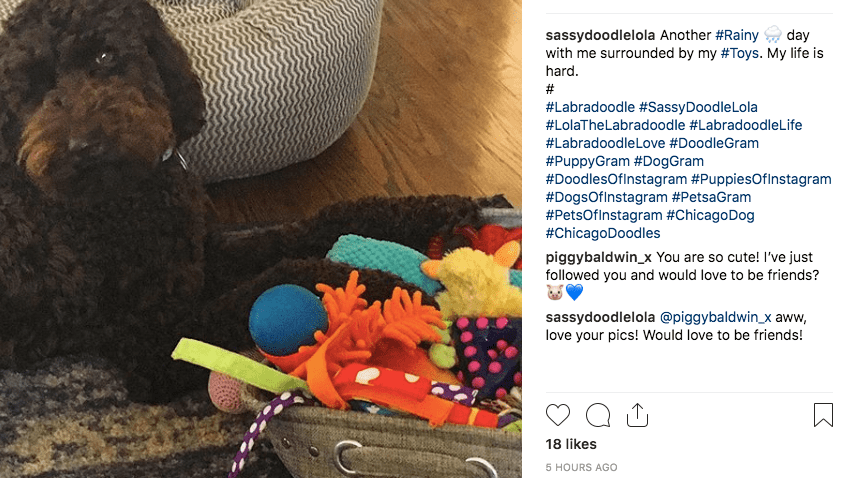Chances are, if you’re reading this, you already know what a hashtag is.
For those who don’t, here’s how I explain hashtags to my relatives (internet-savvy, but not great at social media), as well as the thought process that guides my tagging process:
The best way to think of hashtags is as a “searchable context” that makes content easier to find.
Let’s use an Instagram account I started for my boyfriend’s dog, Lola, as an example. The essentials: Lola is a labradoodle, a brat, and just turned a year. This is information that hashtag searchers could be using to filter their search, albeit in different terms.
However, I don’t want to put all that information in the direct caption – it takes away from the message I’m trying to share and clutters the brand voice that I’ve established for Lola. I want people who care about those elements to find it, but a bulky caption? Not on my watch.
So rather than putting something clunky like “My name is Lola and I’m one year old playing in with all my toys while it rains outside” I was able to make this post thanks to a plethora of hashtags:

The text is as follows:
“Another #Rainy 🌧 day with me surrounded by my #Toys. My life is hard.”
With a long list of relevant hash tags:
- #Labradoodle
- #SassyDoodleLola
- #LolaTheLabradoodle
- #LabradoodleLife
- #LabradoodleLove
- #DoodleGram
- #PuppyGram
- #DogGram
- #DoodlesOfInstagram
- #PuppiesOfInstagram
- #DogsOfInstagram
- #PetsaGram
- #PetsOfInstagram
- #ChicagoDog
- #ChicagoDoodles
With this, I’m able to create a caption that’s less stilted (although my original sample above is far from anyone’s best effort), as well as cater to variations of similar searches, expanding the scope of my, I mean, Lola’s potential audience.
Hootsuite has published some best practices for using the tags on Instagram as well. If you have the time, I strongly recommend reading: it applies across platforms, although obviously geared towards Instagram over Twitter or LinkedIn, which is experimenting with suggested tags mid-post.
At the end of the day, including caps has no technical bearing on how much exposure my posts get on any platform: Instagram, Twitter and LinkedIn don’t care about caps.
So why do I use them?
Because English-speakers can read them easily.
HoneyPot Marketing uses a good example following the death of Margaret Thatcher, where original tweets used #nowthatcherisdead over the upper case version: #NowThatcherIsDead. The lack of caps broke into ambiguity with many on Twitter reading as “Now that Cher is dead” rather than “Now Thatcher is dead”.
I don’t think anyone has ever mixed up Cher and Margaret Thatcher before (at least not consciously). If this was a branded hashtag, this would have been a conversion disaster, since the message was completely lost, resulting in no new views, clicks, or purchases: a web content wasteland.
In a landscape where brevity is the norm, clarity and consideration for your audience’s reading expectation is an absolute must. If you’re not catering to your potential audience, you’re alienating them. When an audience is alienated, they scroll past.
Suppose I can take two minutes or so to capitalize my tags. In that case, I can read and identify typos faster, as well as potentially tack on an additionally invested follower when I post.
While I’m not driving viewership directly because of this method, I’m enhancing the experience for readers while building my personal brand…even if the brand is just me forcing people to look at pictures of my #FurBaby in my (unrealistic) quest for premium dog food sponsorship deals.
More about my UX + Content thoughts can be found here.

